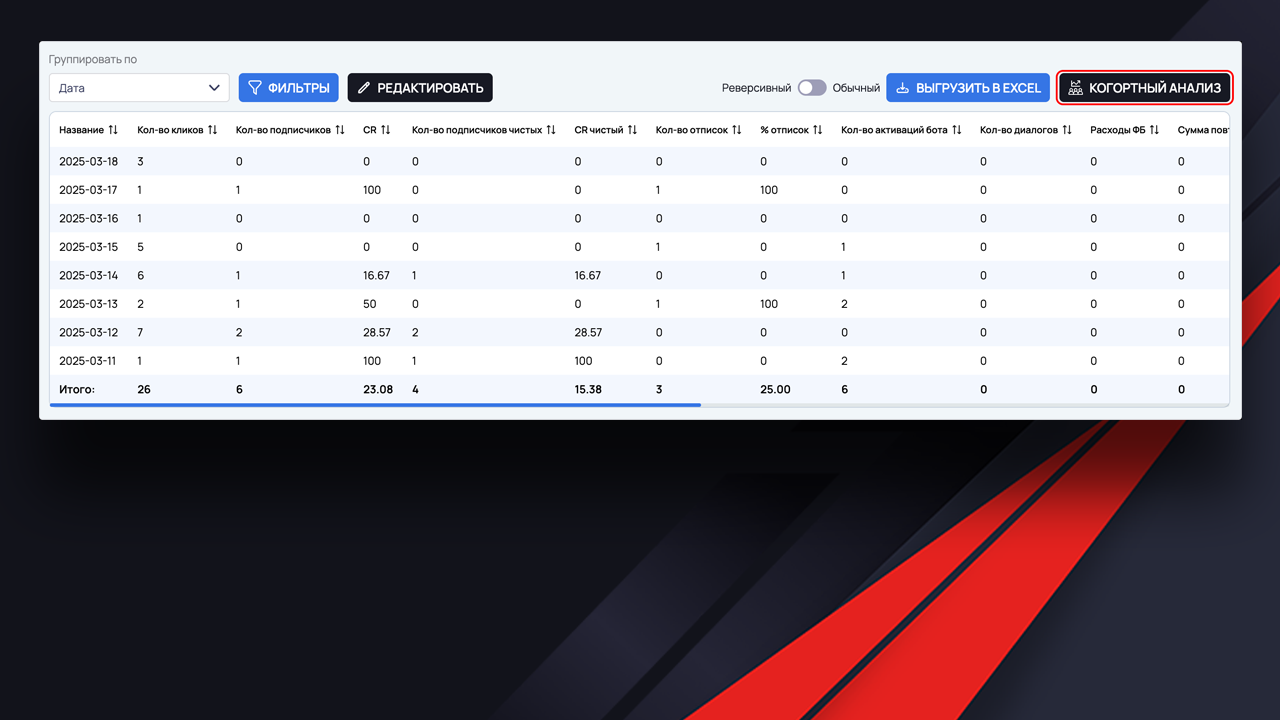Cohort analysis is a method of studying the behavior of users grouped into groups (cohorts) based on a certain characteristic, most often by the date of the first interaction with the product: click on an advertisement, registration, application installation, etc.
This approach allows you not just to look at the overall statistics for all users, but to understand how users who came at different times behave. This is critical for product analysis, marketing, and management decision-making.
A cohort – what is it?
A cohort is a group of users who share a common characteristic. In MVP Project, a cohort is a group of users who clicked on a certain date. This allows you to track the entire path of these users in the following days: subscriptions, registrations, unsubscribes, purchases, etc.
Example:
– The April 14 cohort is all users who clicked on an advertising link on that day.
– We can analyze how they behaved on the 14th, 15th, 16th and beyond: how many signed up, how many registered, how many made a purchase.
Cohort analysis formats in the MVP Project
Two types of cohort analysis are available in the system, allowing analysis for different business problems.
Regular (straight) format
All user actions (registration, purchase, unsubscribe) are recorded by the date of the first interaction – the date of click.
Example:
– The user clicked on April 14, subscribed on the 14th, but bought on the 17th.
– The report will show all of these activities for April 14.
What it’s for:
This format is great when you want to evaluate the effectiveness of your advertising campaigns and understand what traffic is actually converting.

Reversible format
Here, each action is displayed by actual date, but remains linked to the date of the first click.
So you see what the April 14 cohort accomplished on each day that followed.
Example:
– User clicked on April 14, subscribed on the 14th, bought on the 17th.
– The purchase will be recorded for April 17, but broken down by cohort on the 14th.
What it’s for:
The reverse-engineered format is convenient for daily analysis and allows you to understand which days users take key actions to assess decision latency and customer lifecycle.

Advantages of cohort analysis
– An in-depth analysis of behavior. Identifies how users with different entry points behave over time.
– Traffic Quality Assessment. Shows which advertising sources drive the most “long-lasting” and buying users.
– Understanding retention. It’s easy to track how many days users “fall off” after signing up or taking their first action.
– LTV improvement. Based on cohorts, you can understand which changes improve the customer’s lifetime value.
– Change Analysis. You can compare cohort behavior before and after the introduction of a new feature or the launch of a promotion.
– Improved marketing and product. Helps you more accurately determine when and why users take targeted actions.
How to use cohort analysis in MVP Project
1. Choose a click date – this will be the basis of your cohort.
2. Determine the format of the analysis:
– If you need to understand how well the ads work, go for the regular one;
– if you are interested in user behavior by date – reversible.
3. study user behavior: from click to purchase
4. Compare cohorts against each other – which have been most successful in terms of LTV, conversion, retention.
5. Draw conclusions and make changes to the strategy.




No Comment! Be the first one.